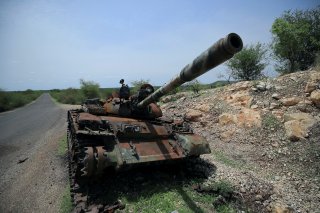The Annual Cost of Weapons Worldwide Is Out Of This World
$3 trillion can buy a LOT of weapons.
Here's What You Need to Remember: The United States accounted for 79 percent of the global arms trade, or an average of $143 billion per year, followed by the European Union at 10 percent, Russia at 5 percent and China at less than 2 percent
The world is spending almost $3 trillion a year on arms.
That’s the estimate of the U.S. government. The State Department’s World Military Expenditures and Arms Transfers (WMEAT) report examined global military spending for 2007 to 2017.
“From 2007 through 2017, in constant 2017 U.S. dollar terms, the annual value of world military expenditures appears to have risen about 11 percent to 33 percent, from about $1.51 trillion to $2.15 trillion in 2007 to about $1.77 trillion to $2.88 trillion in 2017, and to have averaged between $1.72 trillion and $2.61 trillion for the 11-year period,” according to the State Department’s Bureau of Arms Control, Verification and Compliance, which compiled the report.
The huge gap between the high and low range of each number is because converting foreign military spending into U.S. dollars is a difficult process. The study used five different methods to make the conversion. Nonetheless, overall global military spending appears to have risen sharply since 2007.
On the other hand, fewer people are serving in the military, no surprise given that drones and automation are increasingly replacing human soldiers. “The number of people serving in the world’s armed forces appears to have fallen about 3 percent in absolute terms, from about 21.0 million in 2007 to about 20.4 million in 2017, peaking at about 21.3 million in 2008,” the study found. “From 2007 to 2017, the world total of armed forces personnel appears to have fallen about 13 percent in per capita terms, from about 0.32 percent to about 0.28 percent of total population. It appears to have fallen by about 13 percent as a proportion of the labor force, from about 0.69 percent to about 0.60 percent.”
Interestingly, while global military spending has risen, the amount of money spent per soldier has risen even more, again pointing to the trend of replacing people with drones, robots and highly automated platforms such as warships designed to require fewer sailors. “From 2007 through 2017, world military expenditures per armed forces member - an indicator of the capital-intensivity of the military - appear to have risen by 15 percent to 38 percent despite rising more slowly after 2009,” noted the study.
Curiously, there were two exceptions where spending per soldier did not rise: North America and East Africa.
Ironically, rich, democratic nations – which like to think of themselves as being the most peaceful – also accounted for a bulk of a global arms trade averaging $181 billion annually. “Countries in the most democratic quintile of world population appear to have accounted for about 92 percent of world arms exports and 50 percent of world arms imports,” the study found.
The United States accounted for 79 percent of the global arms trade, or an average of $143 billion per year, followed by the European Union at 10 percent, Russia at 5 percent and China at less than 2 percent
Arms exports actually had a significant effect on America’s balance of payments. “Over the period, the arms trade surplus of the United States may have offset as much as 24 percent of its total trade deficit,” the study concluded.
Michael Peck is a contributing writer for the National Interest. He can be found on Twitter and Facebook.
This article first appeared last year and is being reposted due to reader interest.
Image: Reuters

